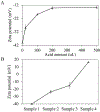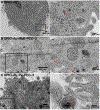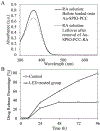Superparamagnetic iron oxide-gold nanoparticles conjugated with porous coordination cages: Towards controlled drug release for non-invasive neuroregeneration
- PMID: 33872772
- PMCID: PMC8238818
- DOI: 10.1016/j.nano.2021.102392
Superparamagnetic iron oxide-gold nanoparticles conjugated with porous coordination cages: Towards controlled drug release for non-invasive neuroregeneration
Abstract
This paper reports a smart intracellular nanocarrier for sustainable and controlled drug release in non-invasive neuroregeneration. The nanocarrier is composed by superparamagnetic iron oxide-gold (SPIO-Au) core-shell nanoparticles (NPs) conjugated with porous coordination cages (PCCs) through the thiol-containing molecules as bridges. The negatively charged PCC-2 and positively charged PCC-3 are compared for intracellular targeting. Both types result in intracellular targeting via direct penetration across cellular membranes. However, the pyrene (Py)-PEG-SH bridge enabled functionalization of SPIO-Au NPs with PCC-3 exhibits higher interaction with PC-12 neuron-like cells, compared with the rhodamine B (RhB)-PEG-SH bridge enabled case and the stand-alone SPIO-Au NPs. With neglectable toxicities to PC-12 cells, the proposed SPIO-Au-RhB(Py)-PCC-2(3) nanocarriers exhibit effective drug loading capacity of retinoic acid (RA) at 13.505 μg/mg of RA/NPs within 24 h. A controlled release of RA is achieved by using a low-intensity 525 nm LED light (100% compared to 40% for control group within 96 h).
Keywords: Intracellular targeting; Non-invasive neuroregeneration; Porous coordination cages; Superparamagnetic iron oxide-gold nanoparticles; Sustainable and controlled drug release.
Copyright © 2021 Elsevier Inc. All rights reserved.
Conflict of interest statement
The authors declare no conflict of interest.
Figures








Similar articles
-
Engineered nanomedicine for neuroregeneration: light emitting diode-mediated superparamagnetic iron oxide-gold core-shell nanoparticles functionalized by nerve growth factor.Nanomedicine. 2019 Oct;21:102052. doi: 10.1016/j.nano.2019.102052. Epub 2019 Jul 23. Nanomedicine. 2019. PMID: 31349088 Free PMC article.
-
Promoting neuroregeneration by applying dynamic magnetic fields to a novel nanomedicine: Superparamagnetic iron oxide (SPIO)-gold nanoparticles bounded with nerve growth factor (NGF).Nanomedicine. 2018 Jun;14(4):1337-1347. doi: 10.1016/j.nano.2018.03.004. Epub 2018 Apr 5. Nanomedicine. 2018. PMID: 29627520
-
Mesoporous silica nanoparticles combining Au particles as glutathione and pH dual-sensitive nanocarriers for doxorubicin.Mater Sci Eng C Mater Biol Appl. 2016 Feb;59:258-264. doi: 10.1016/j.msec.2015.10.022. Epub 2015 Oct 14. Mater Sci Eng C Mater Biol Appl. 2016. PMID: 26652372
-
Recent advances in theranostic nanocarriers of doxorubicin based on iron oxide and gold nanoparticles.J Control Release. 2013 Jul 10;169(1-2):48-61. doi: 10.1016/j.jconrel.2013.03.018. Epub 2013 Apr 6. J Control Release. 2013. PMID: 23567046 Review.
-
Porous aerogel and core/shell nanoparticles for controlled drug delivery: A review.Mater Sci Eng C Mater Biol Appl. 2019 Mar;96:915-940. doi: 10.1016/j.msec.2018.11.067. Epub 2018 Dec 1. Mater Sci Eng C Mater Biol Appl. 2019. PMID: 30606605 Review.
Cited by
-
Progress, Opportunities, and Challenges of Magneto-Plasmonic Nanoparticles under Remote Magnetic and Light Stimulation for Brain-Tissue and Cellular Regeneration.Nanomaterials (Basel). 2022 Jun 29;12(13):2242. doi: 10.3390/nano12132242. Nanomaterials (Basel). 2022. PMID: 35808077 Free PMC article. Review.
-
Multifunctional quantum dot-decorated drug-loaded magnetite nanosystem for dual optical-magnetic resonance imaging and drug delivery.RSC Adv. 2025 Jun 23;15(27):21269-21283. doi: 10.1039/d5ra03379a. eCollection 2025 Jun 23. RSC Adv. 2025. PMID: 40556697 Free PMC article.
-
Magnetic Fields and Magnetically Stimulated Gold-Coated Superparamagnetic Iron Oxide Nanoparticles Differentially Modulate L-Type Voltage-Gated Calcium Channel Activity in Midbrain Neurons.ACS Appl Nano Mater. 2022 Jan 28;5(1):205-215. doi: 10.1021/acsanm.1c02665. Epub 2022 Jan 5. ACS Appl Nano Mater. 2022. PMID: 40342618 Free PMC article.
References
-
- Lu XC, Zheng JY, Tang LJ, Huang BS, Li K, Tao Y, Yu W, Zhu RL, Li S,Li LX. MiR-133b Promotes neurite outgrowth by targeting RhoA expression. Cell Physiol Biochem 2015;35:246–58. - PubMed
-
- Garbayo E, Ansorena E, Lana H, del Mar Carmona-Abellan M, Marcilla I, Lanciego JL, Luquin MR,Blanco-Prieto MJ. Brain delivery of microencapsulated GDNF induces functional and structural recovery in parkinsonian monkeys. Biomaterials 2016;110:11–23. - PubMed
-
- Herrán E, Requejo C, Ruiz-Ortega JA, Aristieta A, Igartua M, Bengoetxea H, Ugedo L, Pedraz JL, Lafuente JV,Hernández RM. Increased antiparkinson efficacy of the combined administration of VEGF-and GDNF-loaded nanospheres in a partial lesion model of Parkinson’s disease. Int J Nanomed 2014;9:2677. - PMC - PubMed
-
- Rodríguez-Nogales C, Garbayo E, Carmona-Abellán MM, Luquin MR,Blanco-Prieto MJ. Brain aging and Parkinson’s disease: new therapeutic approaches using drug delivery systems. Maturitas 2016;84:25–31. - PubMed
Publication types
MeSH terms
Substances
Grants and funding
LinkOut - more resources
Full Text Sources
Other Literature Sources

